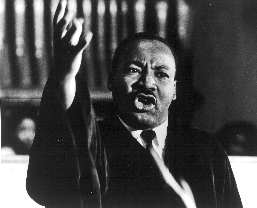Chapter 1
Preface
Pages 1-2-3
-
Chapter 2
Lessons
Pages 4-5-6
-
Chapter 3
Values
Pages 7-8-9
-
Chapter 4
Anger
Pages 10-11-12
-
Chapter 5
Action
Pages 13-14-15
-
Chapter 6
Affiliation
Pages 16-17-18
-
Chapter 7
Integration
Pages 19-20-21
-
Chapter 8
World-Historic Consciousness
Pages 22-23-24-25-26
-
Chapter 9
Universality
Page 27
-
Chapter 10
Root Causes
Pages 28-29-30
-
Chapter 11
The New Psychology
Pages 31-32-33
-
Acknowledge-
ments
Page 37
In one autobiography after another we find the same story - the initial action for peace and justice is motivated by anger against injustice. Like the spark that ignites the fuel in an engine, anger is the stimulus that initiates action (footnote 5).
 |
Martin Luther King, Jr., Nobel peace laureate: "The supreme task is to organize and unite people so that their anger becomes a transforming force." |
It was anger that transformed W.E.B. DuBois from a scholar, brilliant but ineffective in a world of exploitation and racism, into a powerful activist for civil rights:
At the very time when my studies were most successful, there cut across this plan which I had as a scientist, a red ray which could not be ignored. I remember when it first, as it were, startled me to my feet....The news met me: Sam Hose had been lynched, and they said that his knuckles were on exhibition at a grocery store....I began to turn aside from my work....One could not be a calm, cool, and detached scientist while Negroes were lynched, murdered, and starved.
A bit later in his autobiography, DuBois describes how anger eventually stimulated him into activity, the founding of the Niagara Movement which later developed into the NAACP:
But when Trotter went to jail, my indignation overflowed. I did not always agree with Trotter then or later. But he was an honest, brilliant, unselfish man, and to treat as a crime that which was at worst mistaken judgment was an outrage. I sent out from Atlanta in June 1905 a call to a few selected persons "for organized determination and aggressive action...."
In recalling his activities on behalf of conscientious objectors in World War I, which began his long career of peace activism, Bertrand Russell explains how he had become "filled with despairing tenderness towards the young men who were to be slaughtered, and with rage against all the statesmen of Europe." Similarly, Helen Caldicott, inspired a generation later by the example of Bertrand Russell, took her first steps of peace action when "I became indignant."
Not all anger is useful for consciousness development. The anger that can be harnessed to action and consciousness development is anger directed against the institutions of war and injustice, rather than anger directed against individuals as such. "You must not harbor anger," Martin Luther King Jr. admonished himself at one point in his autobiography when speaking about a personal anger. But in describing the growing demand for bus desegregation in Montgomery, King made it clear that anger is essential as a motive for action, as "there had developed beneath the surface a slow fire of discontent, fed by the continuing indignities and inequities to which the Negroes were subjected." Debs, upon his release from prison in 1895 where he had been confined in order to break the national railway strike, expressed it this way: "there has been no liberty in the world....for the maintenance of which man has not been required to fight." He was echoing the motto of Frederick Douglass, the American slave who fought his way to freedom and became a hero of the emancipation a generation before: "without struggle, there can be no progress."
(continued on next page)
 |
 |
 |